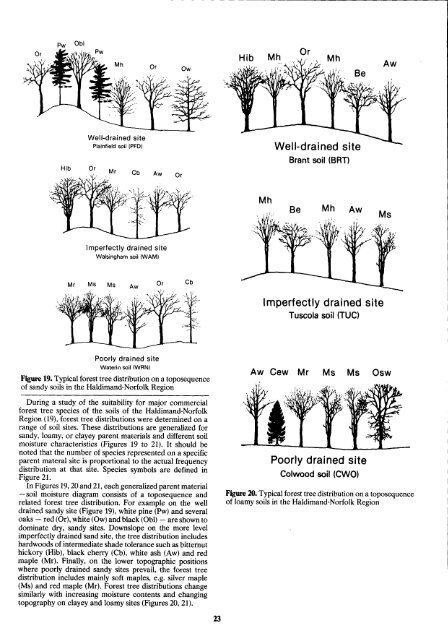Soil Report - Agriculture et Agroalimentaire Canada
Soil Report - Agriculture et Agroalimentaire Canada
Soil Report - Agriculture et Agroalimentaire Canada
Create successful ePaper yourself
Turn your PDF publications into a flip-book with our unique Google optimized e-Paper software.
Well-drained site<br />
Plainfield soil (PFD)<br />
Imperfectly drained site<br />
Walsingham soil (WAM)<br />
Poorly drained site<br />
Waterin soil (WRN)<br />
Figure 19 . Typical forest tree distribution on a toposequence<br />
of sandy soils in the Haldimand-Norfolk Region<br />
During a study of the suitability for major commercial<br />
forest tree species of the soils of the Haldimand-Norfolk<br />
Region (19), forest tree distributions were d<strong>et</strong>ermined on a<br />
range of soil sites . These distributions are generalized for<br />
sandy, loamy, or clayey parent materials and different soil<br />
moisture characteristics (Figures 19 to 21) . It should be<br />
noted that the number of species represented on a specific<br />
parent materal site is proportional to the actual frequency<br />
distribution at that site . Species symbols are defined in<br />
Figure 21 .<br />
In Figures 19, 20 and 21, each generalized parent material<br />
-soil moisture diagram consists of a toposequence and<br />
related forest tree distribution. For example on the well<br />
drained sandy site (Figure 19), white pine (Pw) and several<br />
oaks - red (Or), white (Ow) and black (Obl) - are shown to<br />
dominate dry, sandy sites. Downslope on the more level<br />
imperfectly drained sand site, the tree distribution includes<br />
hardwoods of intermediate shade tolerance such as bittemut<br />
hickory (Hib), black cherry (Cb), white ash (Aw) and red<br />
maple (Mr) . Finally, on the lower topographic positions<br />
where poorly drained sandy sites prevail, the forest tree<br />
distribution includes mainly soft maples, e.g . silver maple<br />
(Ms) and red maple (Mr) . Forest tree distributions change<br />
similarly with increasing moisture contents and changing<br />
topography on clayey and loamy sites (Figures 20, 21) .<br />
23<br />
Hib Mh<br />
Well-drained site<br />
Brant soil (BRT)<br />
Imperfectly drained site<br />
Tuscola soil (TUC)<br />
Poorly drained site<br />
Colwood soil (CWO)<br />
Aw<br />
Aw Cew Mr Ms Ms Osw<br />
Figure 20. Typical forest tree distribution on a toposequence<br />
of loamy soils in the Haldimand-Norfolk Region

















